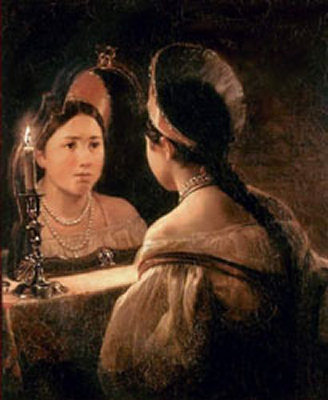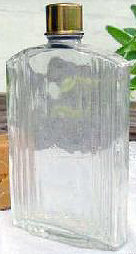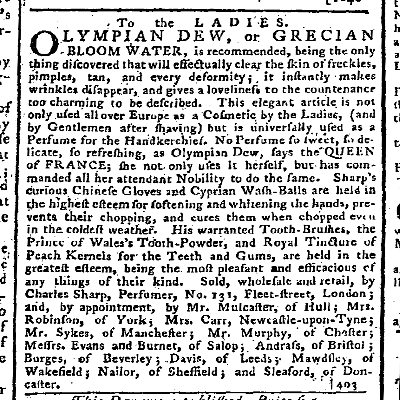Looking Your Best
Women have always wanted to look attractive and pretty, as today so in times of old. In Arabella a, Georgette Heyer wrote:

Through all times and ages have women tried to improve their skin and combat the signs of aging;
the Regency era was no exception. Lotions abounded, each more exotic than the other. Home
made remedies existed alongside the fanciful commercial products and the efficacy
of either may well have been the same. This article discusses some of the more
famous of the beauty aids on the well dressed Regency woman's vanity.
Looking Your BestWomen have always wanted to look attractive and pretty, as today so in times of old. In Arabella a, Georgette Heyer wrote: |  |
In reality, many of these products were lethal, as they contained such poisonous substances as lead and mercury. Regarding Bloom of Ninon de L'Enclos, The Gazette of Health d states: Below we will look at some of the most famous lotions of the era. Please note that in the Regency era what we today call cleansers, face tonics or moisturizers were often jointly referred to under the one word lotions. Each lotion is presented with the advertised text, use and recipe, when know. Unfortunately I have yet to locate any bottles or labels for these remedies, probably due to the fact that the paper labels have disintegrated over the year, so even if the bottles still exist we have no certain way of identifying them. Gowland's Lotion |
 Regency era lotion bottle. As the paper labels used easily washed off I have yet to locate any intact bottles with labels. |
During the Regency the Gowland's Lotion may have been the most famous of them all. Prepared by Macdonald, Humbert, & co. in Longacre, it was priced at 6s. the Quart. e Said to cure everything from pimples to scrophula, this lotion was a must have for the fashionable lady of the era. It was not for everyday use but to combat sudden eruptions of the skin, sunburn etc. In Modern domestic medicine f Thomas John Graham commented "These red, stationary pimples in the face, form a complaint called by professional men gutta rosea, and are often a source of much disgust to the female part of society. Gowland's lotion is a favourite remedy for their removal; but, as it is a solution of corrosive sublimate, it is by no means safe." The Medical lexicon g gives the following information on the recipe: "Lotion, Gowland's. An empirical preparation (Bitter almond, sugar, distilled water. Grind together, strain and add corrosive sublimate, previously ground with spiritus vini rectified.) Used on obstinate eruptions." and The Modern Practice of Physic h further explains the formula as "A remedy much employed by women who are troubled with eruptions in the face is Gowland's lotion, the basis of which is the oxymuriate of mercury or superacetate of lead; but it is a hazardous application when continued for any length of time." It was obviously best suited to oily skin, although the addition of mercury and/or lead would indeed make it unsafe! |
Milk of RosesOne of the most efficacious, and a product that actually delivered on some of its promises, was Warren and Rosser's Milk of Roses. i An 1819 ad called it "the most delightful cosmetic in Europe" and goes on to say that "It is highly recommended, not only by the proprietor, but by most females of distinction, for clearing and preserving the skin, and for rendering the complexion delicately fair and beautiful: it entirely removes redness, sunburn and freckles." A product of the mid eighteenth century, it contained, surprisingly enough, no injurious substances, such as lead or mercury so predominant in beauty products of the era. The new family receipt book j has the preparation of Warren's Milk of Roses as following: "Two ounces of rose water, a tea-spoonful of oil of sweet almonds, and twelve drops of oil of tartar must be put into a bottle, and the bottle well shaken till the whole combines." The combination of rose water and almond oil, both still in extensive use in today's skin care industry and known for their healing properties, made it a good remedy for dry to normal skin. The oil of tartar served as a preservative, although this oil based product would still have a rather limited shelf-life, best kept in a cool, dark place to prevent the oil from becoming prematurely rancid. Olympian Dew | |
One of the most well known lotions was the Olympian Dew, also known as Grecian Bloom Water. k It's efficacy was lauded in verse by poets such as George Crabbe, l who wrote:
I have not found any recipes for this concoction but, since it's also referred to as a scent or perfume, o we might draw the inference that this lotion is actually a face tonic. The main ingredient would probably be rose water, which is a well known astringent and would help close up the pores, making the skin appear finer. It might have been similar to the French toilet water Eau d'Ange (Angel's Water), p which contained benzoin, q known for its healing properties and to whiten the skin, rose water, sweet sedge (calamus) and orange water. |

|
Bloom of NinonIf Olympian Dew was a rather benign product, the same could not be said about the 'incomparable' Bloom de Ninon, r touted by its makers as "superior to any thing yet discovered for rendering the skin soft, smooth and beautiful in the extreme. Its wonderful effects in removing freckles, morphews, worms, &c, justly entitle it to that preference so long bestowed on it by the most elegant beauties in this kingdom." As mentioned above, the active ingredients was dangerous white lead. Whatever it's poisonous qualities, it remained popular far into the century and it's still listed in The House of Commons 1830's list of taxable medicines. s During the Regenecy it was sold for 4s. 6d. a bottle, cetainly netting the proprietor a good return as it was evaluated by doctors to cost about one penny to make. t | |
Denmark LotionDenmark Lotion was historical fiction writer Georgette Heyer's favorite, as it crops up time and again in her books. The existence of this lotion is verified, The Toilette Of Health, Beauty, And Fashion u has a recipe for it, although this author doubts very much whether it was ever advertised in the journals - at this point no such ads have surfaced - the inclusion of fresh cream and milk in the recipe must have given it a very short shelf-life. It's interesting to note that this is not the same concoction as the one going under the name the Lotion of the Ladies of Denmark v, which was very different and, if the writer of Encyclopédie méthodique w is to be believed, contained raw pigeon meat! Also observe that both these 'lotions' were cleansers (or 'washes', as the Regency era referred to them) and not for the protection of the skin, which set them apart from moisturizers such as the aforementioned Bloom of Ninon and Milk of Roses. |
|
Pictures:
Notes on the text:
|
| . | . |